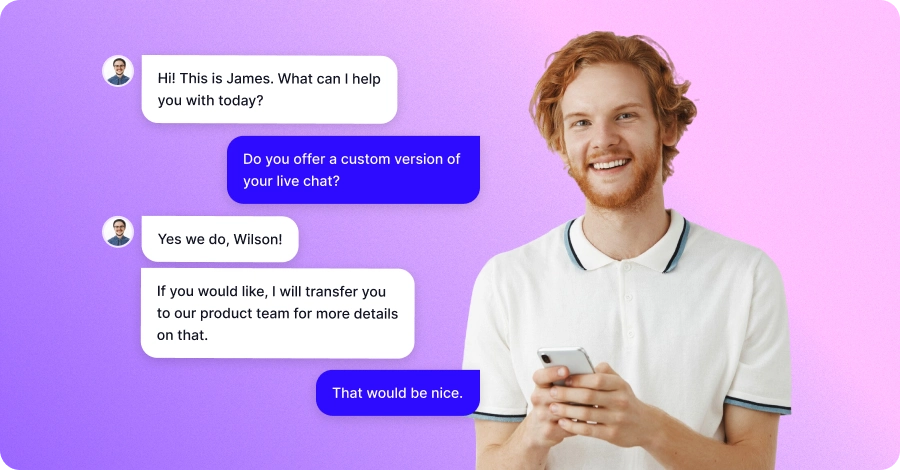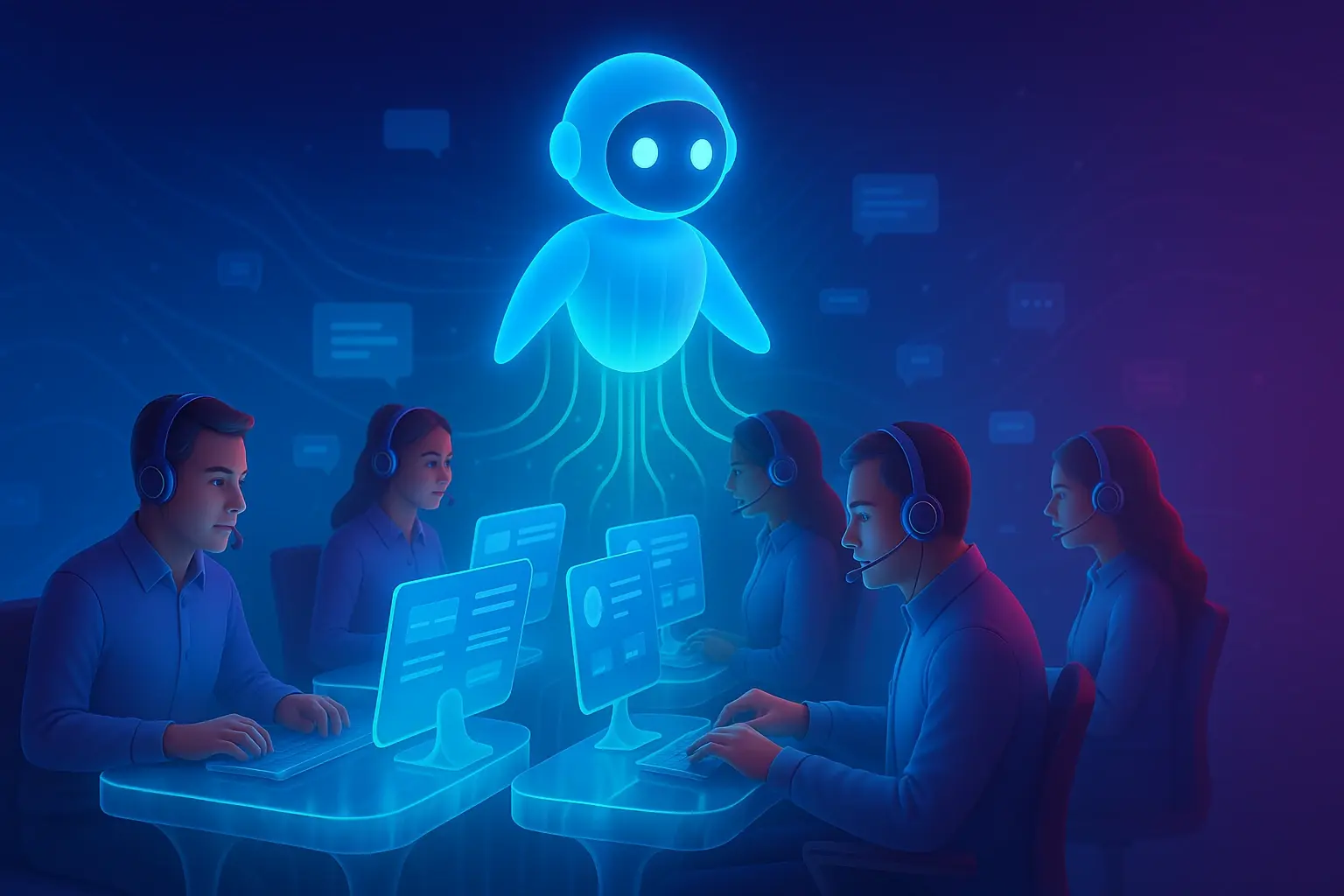Customer Service Guidelines: The Key to Awesome Customer Experience
- April 10, 2023
- 13 mins read
- Listen

Providing great customer service is never an accident. It’s always the result of a well-planned strategy and its subtle execution. If a business is maintaining the quality of customer service for a long time, it means there is a proper system in place for handling customer communications and resolving their issues.
But the question is, how some businesses can offer quality customer services while others are not?
Customer service guidelines are the answer! Companies that follow these guidelines are able to keep their customers happy and elevate their brand value as well. On the other hand, those not following the guidelines can face unsatisfied customers and may witness lost business.
So, offering excellent service is all about staying true to the rules and standards and helping customers through their problems. A business that is ready to follow guidelines will surely reap the rewards in the form of loyal customers.
In this blog, we will explore everything about the guidelines for customer service.
What are Customer Service Guidelines?
Customer service guidelines are a set of principles that organizations follow to serve their customers and offer quality services to them. These guidelines work as rules for handling customers and meeting their needs with the business.
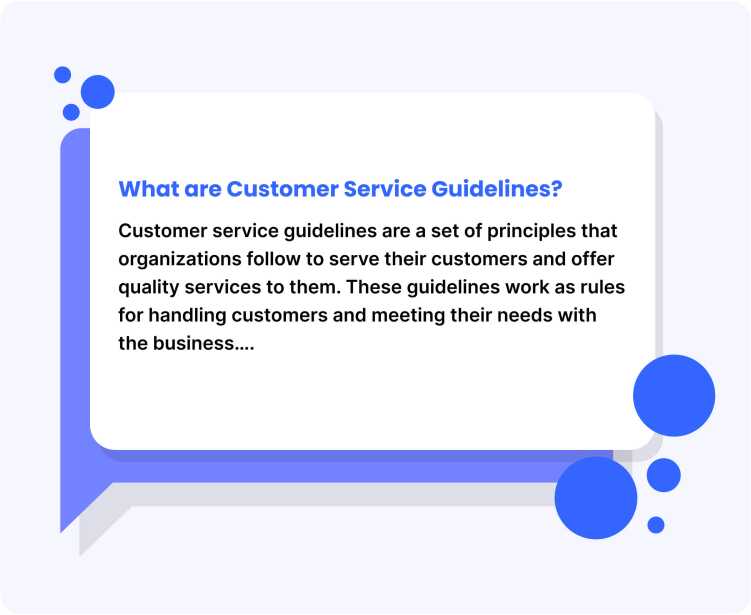
Using customer service guidelines, agents are able to understand various key things such as how to offer assistance, how to resolve issues, how to communicate, and how to behave with them. In addition, the purpose of following these guidelines is to maintain consistency with different aspects of communication such as the tone of voice, body language, manners of greeting customers, etc.
In addition, teams that follow customer service call handling guidelines are able to positively impact the customer’s experience with the brand, resulting in improved satisfaction and loyalty.
Why Businesses Need Customer Service Guidelines?
Customers always have high expectations and they look for a positive experience to stay loyal to a brand. In fact, 77% of consumers think good customer service is key for businesses to earn brand loyalty. Such experiences can never be delivered unless a business has customer service guidelines in place.
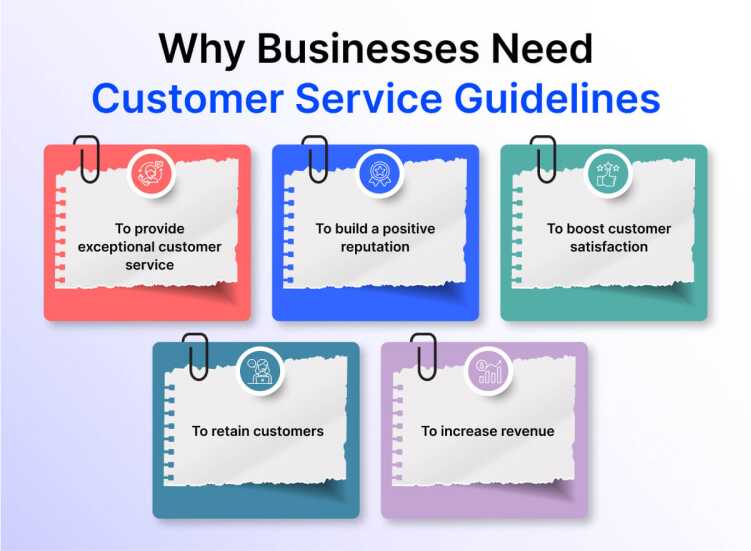
Reasons are many why a business needs to follow customer service call-handling guidelines:
- To provide exceptional customer service – Following customer service guidelines is the only way to offer great service to customers and win their loyalty. When customers show loyalty, it has a big impact on the bottom line.
- To build a positive reputation – Providing excellent customer service is the only way a business can build and maintain a positive reputation in the industry. When a business has a positive reputation among customers, it enjoys increased customer loyalty.
- To boost customer satisfaction – A business that follows customer service guidelines is more likely to offer quality service, resulting in more satisfied customers. When the level of customer satisfaction is high, it can always have a positive impact on profits and revenue.
- To retain customers – Following customer service guidelines is a way for the business to show that it cares for customers, values them, and respects them. When a business has that kind of approach to customers, it stands to achieve an improved retention rate and more repeat purchases.
- To increase revenue – No business can provide exceptional customer service unless it follows the standards and guidelines of service. Those who do can witness increased sales and revenue as customers often show loyalty to businesses that care for them.
Most Common Customer Service Communication Guidelines
Customer communication is often the foundation upon which the success of a business depends. A business that knows how to communicate well with customers always performs better in the market and enjoys customer trust and goodwill. However, good communication is never possible without following industry standards and guidelines.
Here are some of the most common customer service communication guidelines a business needs to follow to serve customers exceptionally well –
1. Listen Actively
Active listening is a key customer service guideline that every business needs to follow if they want to better understand the needs and concerns of their customers. If a customer service team does not listen actively, it may never be able to understand customer needs & preferences, resulting in frustrating experiences for customers.
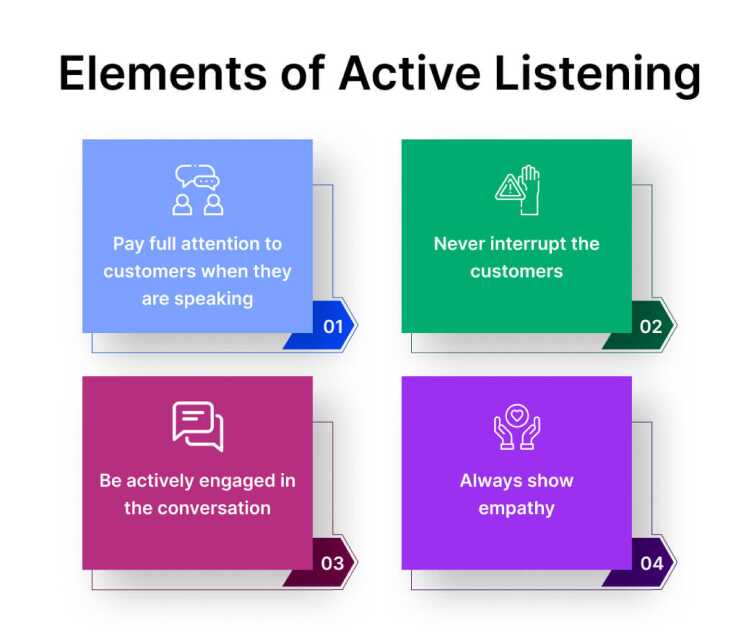
Active listening can happen only when agents follow many things, including –
- Pay full attention to customers when they are speaking and never let any distractions come in the way when the customer is saying something.
- Never interrupt the customers and always wait for them to finish before giving them responses.
- Be actively engaged in the conversation, ask questions and if any doubt, politely let the customer know so that their messages can be understood fully.
- Always show empathy when a customer approaches you with a problem as being empathetic can help you better understand their concerns and their standing.
2. Respond Promptly
Customers always expect a timely response when they approach a business with a question or concern. If the response is not quick, customers might think that the business does not care about them or their needs. In fact, failing to respond in a prompt manner can cause frustration to customers and this can erode their trust in the business.
Responding promptly to customers can come with certain key elements, including –
- Set up an auto-reply email or messaging system so that you can be prompt in response and also quickly acknowledge their message.
- Always provide customers with an estimated response time so that they can set expectations and be aware of when to expect a response.
- Give utmost priority to urgent issues of customers and in such matters always respond as promptly as you could.
- You can also use technology such as live chat software and AI-powered chatbot to offer quick responses to customers.
3. Treat Customers with Respect
Treating customers with respect and courtesy is a key customer service guideline because it shows that a business values and respects its customers. If a service team fails to be respectful and courteous, it might damage customer relationships which can lead to a loss of goodwill over time.
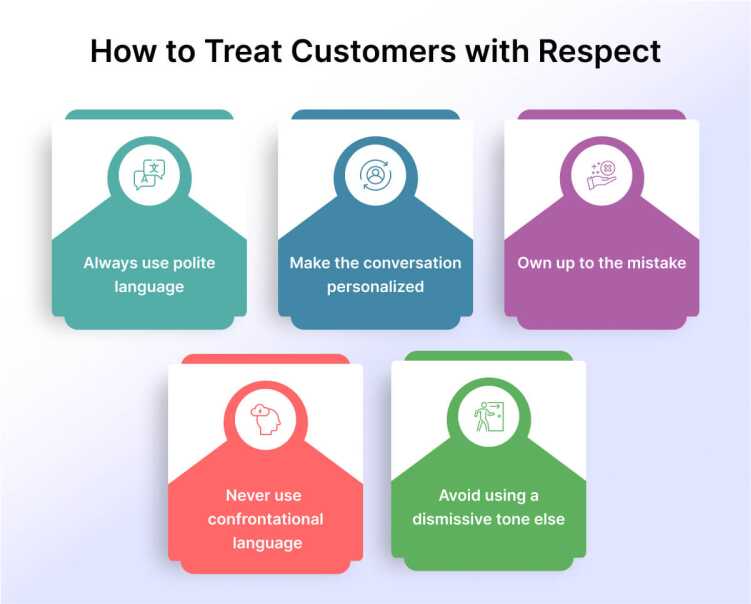
Being respectful and courteous in customer service can mean many things, including –
- Always use polite language to show that you value customers and respect their association with your business.
- Make the conversation personalized by using a customer’s name as this will show that you respect their individual needs.
- Be ready to own up to the mistake and say sorry as it shows to customers that you’re ready to take responsibility for the issue.
- Never use confrontational language with customers or avoid using a dismissive tone else you might risk losing first their trust and then their stay with your business.
4. Adopt a Proactive Approach
Your approach to handling customer issues and how you solve their problems is way more important than just meeting their needs successfully. When you adopt a proactive approach to offer solutions, it means you’re ready to go beyond the rulebook and add value to the customers. It also means you’re ready to do whatever it takes to ensure that the customer’s needs are met.
Adopting a proactive approach is important in customer service for many reasons:
- Being proactive in helping the customer demonstrates that you care about their experience and you are ready to take every possible measure to ensure they are happy.
- Adopting a proactive approach shows your commitment to finding a solution in even those situations where the problem is not easy to handle.
- When you are proactive in helping customers, you basically aim to address the customer issues promptly and effectively without letting the matter escalate.
5. Have a Complete Understanding of Your Product and Process
It takes a trained team to provide excellent service and elevate the experience of customers. When we say a trained team, it means a team that is knowledgeable and has an in-depth understanding of the products, services, processes, procedures, and policies.
Only an informed team can provide customers with accurate and useful information and add to their overall experience with the brand. So much so, only a good team can ensure a great experience and such experiences are the reason 62% of customers can refer a brand to friends.
Having a complete understanding of the product and service is helpful for many reasons, including –
- Customers expect accurate and detailed information when they contact a service team as it builds confidence in them about the product or service.
- A customer service team that is familiar with every aspect of the business and has subject knowledge can easily meet the specific needs of customers.
- When customers are happy with the service provided by a trained team, they are more likely to feel happy with the product and less likely to complain or return the product.
6. Personalize the Experience For Your Customer
Personalization is one of the keys to providing excellent customer service. When a company personalizes the experience, customers feel happy as their individual needs and preferences are catered to. In fact, brands that use the power of personalization are able to build trust and loyalty together with offering a better level of engagement to their customers.
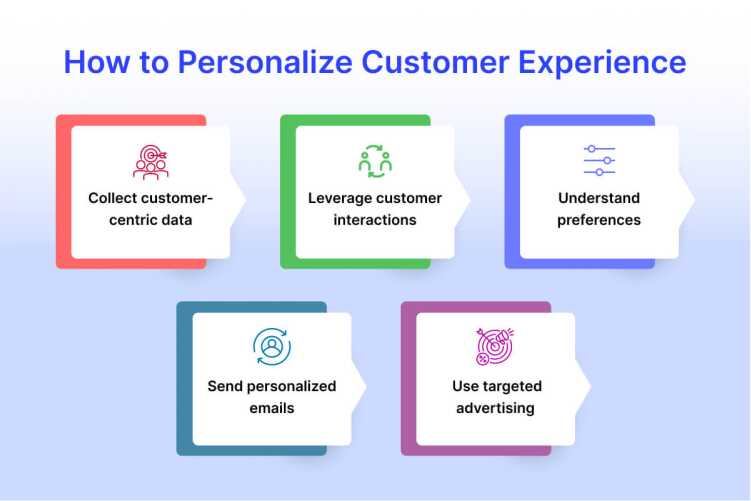
Some of the ways to personalize the customer experience include:
- You should always collect customer-centric data from various interactions and transactions to better understand their preferences and provide personalized service to them.
- It’s important to provide personalized solutions that align with the specific needs of the customers and enhances their experience with your brand.
- Sending personalized emails, using targeted advertising, or offering on-site recommendations are some of the helpful ways to personalize the experience for customers.
7. Use Positive Language
When customers reach out to a business with problems or questions, they expect to be treated with respect and empathy. They also expect the service team to be friendly and supportive. More importantly, they want to be greeted in a welcoming manner to feel good about the situation. All this can never happen if the service team does not understand the value of using positive language with customers. By using positive language, your business can not only improve the overall experience for customers but can also win their long-term loyalty as well.
Using positive language in customer service means:
- Being positive in approach towards helping customers is one of the cornerstones of offering great service. The language you use can give a hint of whether or not you’re willing to help or go the distance for a customer problem.
- Always use affirmative language and offer reassurances instead of adopting an “it-is-not-possible” attitude with customers.
- A good customer service team expresses empathy and understands the value of being empathetic in dealing with customers.
- It’s a good practice to thank the customers and show them appreciation for their trust, time, and effort in reaching out for help.
8. Follow-Up with Customers
Following up with customers is a critical aspect of forging strong relationships and providing customer satisfaction. When agents follow up, it gives customers a sense of being valued. More importantly, following up is essential to ensure that the issue has been resolved and the customer is happy with the product or service.
Your service team needs to understand a few things when they plan to effectively follow up with customers –
- It’s important to use the right channel to follow up and agents must use the channel that customers prefer for communication.
- Following up with customers timely and promptly is key to enhancing customers’ experience and coming across as responsive and reliable.
Examples of Brands Following Customer Service Guidelines
Offering amazing customer service involves strategic planning and the will to serve customers well. Some businesses have managed to redefine customer service year after year, showing how it should be done.
Here are some great examples of companies following customer service guidelines –
- Tesla – Value your customers no matter how far they call you
Tesla is an American automotive company that knows how to serve customers in every situation with distance no bar. The company has a policy of meeting customers where they are and fixing their cars at their homes, or at a location of their choice. The Tesla example is a good lesson in understanding the role of quality service delivery at the convenience of customers.
- Virgin Atlantic Airlines — Take customer complaints as a gift to improve
Not every company is good at handling customer complaints and that’s why not every company can reach the height of Virgin Airlines. Once a customer in the first class complained of a dreadful food experience and wrote a letter to the founder Branson himself. The result: Branson not only invited the passenger but also asked him to help Virgin overhaul its menu.
Use Powerful Tools And Effectively Meet Customer Service Guidelines
Meeting customer service guidelines is not easy for businesses that lack the proper tools at their disposal. You should understand the need for high-quality tools and technology to offer great customer service.
There are a range of engagement tools that can help any business provide amazing service to customers and win their loyalty. Using AI-powered chatbots, it’s possible to automate some parts of the support and offer prompt responses.
Quality video chat and co-browsing software can ensure great value to visual engagement and help businesses offer personalized support. In addition, feature-rich live chat software can be paired with bots to offer hybrid support and boost customers’ experience with your brand.
Conclusion
At REVE Chat, we realize the significance of meeting customer service communication guidelines and offering value to customers at each stage of their journey.
We are also aware of how a business needs to keep pace with the technology around it and needs to have the right tools to meet the industry standards in customer service.
You can sign up with us and test our world-class engagement tools.
Frequently Asked Questions
Customer service guidelines are a set of rules or principles to serve customers and offer them quality services. Organizations follow these guidelines to better handle customers and meet their needs successfully.
Businesses need customer service guidelines for many reasons, including:
- To offer great service to their customers and win their trust or loyalty
- To build a positive brand image and reputation among customers
- To adopt a customer-centric approach and enhance customer satisfaction
- To show customers how much care and respect they deserve
- To create happy customers, leading to more profits and revenue
Every customer-facing agent should use service guidelines to ensure quality and value in the delivery of service. When an agent works within standard protocols or a set of rules, he/she always understands their role better, which results in improved service quality.
There are many reasons why agents should use service guidelines:
- To understand the basic principles of service
- To effectively resolve issues faced by customers
- To better communicate with customers
- To maintain consistency in service communication
- To ensure help is available to customers when needed
Some of the most common service communication guidelines are:
- Actively listening to customers and their problems
- Ensuring quick responses whenever customers approach with problems
- Making customers feel valued and respected
- Being proactive in solving problems rather than waiting for customers to approach
- Gaining complete knowledge of your product, services, and processes to serve customers better
- Giving customers personalized experiences
- Staying in touch with customers through follow-ups
AI can help businesses in many ways to effectively meet customer service guidelines. These ways include:
- Helping businesses provide instant and accurate responses to customer queries
- Making support a 24×7 service for customers and reducing wait times
- Using customer data to personalize interactions and increase customer engagement
- Automating routine queries and handling high volumes of calls to free up human agents for more complex issues

